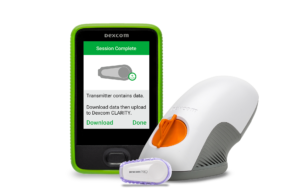
Dexcom VP of Global Clinical Initiatives Tomas Walker [Photo courtesy of Dexcom]
New data is showing that COVID-19 may increase a person’s risk of diabetes, but it could be years until we know for sure.
In the meantime, Dexcom (Nasdaq:DXCM) is getting ready, VP of Global Clinical Initiatives Tomas Walker said.
Walker recently spoke with Medical Design & Outsourcing to discuss the San Diego-based diabetes device developer’s proactive approach to chronic COVID-19 conditions, technology that can help diagnose new cases, and the likelihood that particular devices and components will be in greater demand in the years ahead.
The following has been lightly edited for space and clarity.
MDO: How does the SARS-CoV-2 virus and its COVID-19 disease affect the pancreas?
Walker: In February, March of 2020, there were a couple of papers published out of China very early in the experience of COVID suggesting that anybody who had poorly controlled diabetes had about a fourfold increase in mortality and morbidity. So we knew right away that poorly controlled diabetes was going to be a huge impact on these patients. About the same time, there was some very early autopsy data suggesting that there was evidence of viral infiltration of the pancreas and indeed pretty much every major organ system, and that viral infiltration resulted in the destruction of normal functioning tissue in the organs. Type 1 diabetes — which is the classic that people think about for insulin-dependent diabetes — really relates to the fact that the pancreas can’t produce enough insulin anymore. The beta cells in the pancreas produce insulin, and there was some data published pretty early from the British and the Chinese that COVID infiltrates appeared inside the beta cells of the pancreas, so we knew that this would have repercussions down the road. In addition to that, patients who were hospitalized with severe COVID and mechanically ventilated for weeks were given high doses of steroids. Unfortunately, the effect of steroids is to raise insulin resistance, making it harder for the pancreas to manage the glucose and further stressing those already weakened beta cells. So with regards to the pancreas, it’s absolutely going to be a large factor in long-term COVID for some people. The thing we don’t understand with COVID to this day is still why some people have such a mild course of it and then have no long-term sequela that we can tell, and other people have long COVID syndrome. And that’s going to create quite a bit of a challenge for the medical community. We’re only two years into this. It’s been very long two years of mask mandates and quarantines and lockdowns and no travel, but we’re only two years into this. And I have a feeling that we’re going to learn a lot more over the next two years about the long-term impact of this virus in humans.
MDO: Are there other organs where COVID attacks that might cause diabetes or make it worse?
Walker: The secondary organs I really worry about would be the kidneys and the liver. Diabetes unfortunately remains the No. 1 or 2 cause of kidney failure in the U.S. (along with) hypertension. The liver is also responsible for regulating glucose through the use of glucagon and glucogenesis. But primarily it’s going to be the pancreas and that beta cell reserve and how much damage it actually took with COVID. And it’s going to be a long time for us to see the full impact.
MDO: What’s Dexcom doing to prepare for the way COVID infections will trigger or change diabetes cases?
Walker: It’s important to raise awareness among clinicians about the impact of long-term COVID and potentially more people coming in with Type 2 diabetes. There was even some signal data early on showing that it may be increasing the risk of Type 1 diabetes in some populations also. We’re still waiting on the full effect of this. As far as raising awareness, you know, Dexcom tries to be very proactive. We have a generation of systems called the G6 Pro, which are designed to be used by clinicians to get a pattern of a patient’s glucose value to understand are you really prediabetic, do you really have early Type 2 diabetes and we just didn’t happen to catch it? If you look at the use of that tool, in addition to using things like our standard laboratory test, including hemoglobin A1C and fasting glucose levels or an oral glucose tolerance test, I think we’re looking at expanding options available to clinicians to help them better diagnose early. The data’s pretty solid: diagnose and intervene early in diabetes and have better long-term outcomes.

The Dexcom G6 Pro system with a physician reader for starting the session and downloading data after. [Photo courtesy of Dexcom]
MDO: How does that G6 device work?
Walker: The patch has a little subcutaneous wire into the fatty layer of your skin. And usually it’s worn on the abdomen and it measures the glucose value every five minutes, 288 times a day. So when you start getting glucose value data that dense, you can generate patterns. We can see if your blood sugar levels are always high after breakfast or before bedtime, if your blood sugar really ran up way high after lunch, and maybe it normally should come down within 90 to 120 minutes but your state is elevated for four or five hours before it finally started dropping. That’s all going to provide healthcare providers insight into the fact that a patient may or may not have an evolving problem with their blood sugar.
MDO: Is there a point at which it makes sense to monitor this kind of information for all patients hospitalized with COVID?
Walker: I had that discussion with some clinicians who are trying to run post-COVID and long-term-COVID clinics and it is something that some of them have adopted — at least on a case-by-case basis — is that maybe there’s a place to put this tool on to collect the data and see if maybe we’re not really recognizing that this patient who didn’t have diabetes before may have diabetes now. The label for the G6 Pro system is not just for people with diabetes, it’s for people with or without diabetes, recognizing that there may be a diagnostic component.
MDO: What sort of diabetes-related devices, components and raw materials will be in greater demand in the coming years?
Walker: I’m not an operations or production guy so I probably can’t comment on materials. From a clinical side, there’s a lot of interest in what sort of monitoring or rapid assessment tools can we develop to put into the hands of patients, get data that might help us diagnose patients earlier, and then use that data to treat them earlier, intervene earlier, maybe change the course of prediabetes. There’s still a lot of unknowns there, like can we really change the course of prediabetes? On the clinical side, we’re trying to help support that approach of using these tools in patients who might be at higher risk to get a better, earlier or more appropriate diagnosis.
MDO: What are the most crucial components in the devices that you work with? Are there sensors that are potentially going to be in greater demand?
Walker: The sensors are specifically built for their use. A continuous glucose sensor basically consists of a metal-grade wire covered with some polyvinyl chlorides and some different reactive agents to help measure glucose. As far as the supply chain, I am not aware of any issues related to our supply chain for this and the materials themselves are not that esoteric, not that rare. It’s more of knowing how to put them all together and make them all work together appropriately. That’s the secret sauce.
MDO: How should medtech designers and engineers think differently about doing their jobs in this COVID environment and the years and decades ahead?
Walker: I don’t think it’s entirely related to COVID, but it’s clear — as we face an aging population and increasing chronic health problems and we just dealt with 24 months of a pandemic that killed more than a million people in the U.S. — that we need to look at how to be proactive in healthcare. Can we intervene early? How do we reach out to patients? How can we adapt technology that maybe we have today to meet needs that aren’t being fully addressed, like populations of people with prediabetes or populations of people at high risk for diabetes. An example for this might be that we’ve identified some of the genetic markers for people who are at risk for Type 1 diabetes. So a family has a child who gets diagnosed and then they check the genetic markers on the other kids and the kids are diagnosed. There’s studies looking at medications to intervene earlier, to stop these people from developing the disease. Can we use the technology to say this person has the markers, but for whatever reason, they’re not showing any of the physiology changes we might be expecting? In many ways it’s very humbling. Everything looks really good on paper until you get into the real world. And then you find out that that looks great on paper, but it only actually diagnosed half the people.
Read more: Expect more heart and lung failure years after COVID, Abbott’s heart failure CMO says